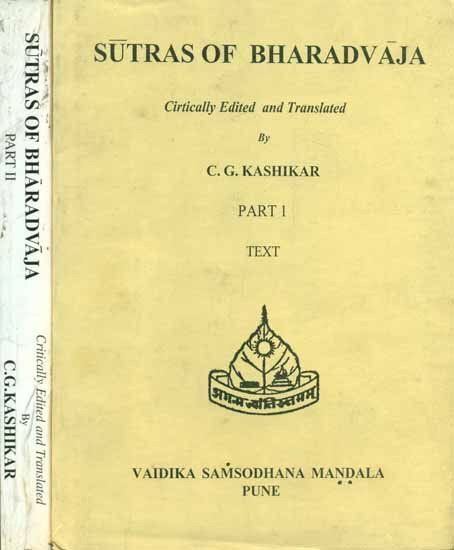Bharadvaja-srauta-sutra
by C. G. Kashikar | 1964 | 166,530 words
The English translation of the Bharadvaja-Srauta-Sutra, representing some of the oldest texts on Hindu rituals and rites of passages, dating to at least the 1st millennium BCE. The term Srautasutra refers to a class of Sanskrit Sutra literature dealing with ceremonies based on the Brahmana divisions of the Veda (Sruti). They include Vedic rituals r...
Praśna 8, Kaṇḍikā 18
1. The Adhvaryu should lay round two enclosing sticks—the middle one and the southern one.[1]
2. The two vidhṛtis should not be laid down.
3. He should deposit the prastara without reciting any formula.
4. The various ladies filled with clarified butter, and the oblations should be placed within the altar one by one.
5. The fire should be carried first, then a pitcher full of water, then the ladles filled with clarified butter, and then the oblations.
6. Or the Adhvaryu should bring the oblations to perfection (and place them within the altar) one by one. According to some teachers, the placing itself of the oblations is their decoration.
7. After the mattress, pillow, collyrium and ointment have been placed one by one towards the south, all should dispose of the prācīnāvīta and adopt yajñopavīta.
8. Then the Adhvaryu should say (to the Hotṛ), “Do you recite the verses for the fire being enkindled for the Devas and the Pitṛs.”
9. The Hotṛ should recite three times the sāmidhenī verse, “Eagerly we invoke thee, eagerly we enkindle thee. Eager, do thou bring the eager, the Pitṛs, to eat the offering.”[2]
10. The Adhvaryu should put the faggot[3] on the fire only at once or dividing it into three parts.
11. After having offered the āghāra-libation by means of the spoon, he should give out a call to the Āgnīdhra, “O Āgnīdhra, do thou cleanse the two enclosing sticks and the fire three times each.”
12. The rites up to the choosing of the Hotṛ should be similar.
13. After having caused the Āgnīdhra to announce (and after the latter has responded), the Adhvaryu should say, “O Hotṛ, do you seat yourself.”
14. This much is the choosing of the Hotṛ.
15. He should not utter the pravaras of the sacrificer, nor should he choose the Hotṛ.[4]
16. He should offer four Prayājas excluding the one to Barhis.
17. After the two Ājyabhāgas[5] have been offered, all should dispose of the prācīnāvīta and adopt yajñopavīta.
18. At this stage some teachers prescribe the enclosing of the altar.
19. The ladles filled with clarified butter should be transposed, the oblations should be transposed, and the officiating priests should also transpose themselves.[6]
20. The Adhvaryu should place the Upabhṛt to the south of the Juhū, and the Dhruvā to the south of the Upabhṛt. He should place the dhānās to the south of the cake, and the meal to the south of the dhānās.
21. The Juhū should be at the same place; the cake should be at the same place; the Brahman and the sacrificer should (also) be at their very places.
Footnotes and references:
[1]:
The northern one instead of the southern one, according to Āpastamba-śrauta-sūtra VIII.14.10. Or optionally he may lay round three enclosing sticks. In that case, he should later on remove the southern one and join it to the middle one. cf. Āpastamba-śrauta-sūtra VIII.14.11,12. Āpastamba-śrauta-sūtra VIII.14.13-15 prescribes the taking down of the oblations and the preparation of the barley meal after the laying round of the enclosing sticks.
[2]:
Taittirīya-saṃhitā II.6.12.1.
[4]:
[5]:
Jīvavant Ājyabhāgas. cf. Āpastamba-śrauta-sūtra VIII. 14.23,24.
[6]:
The Hotṛ, the Āgnīdhra and the Adhvaryu should go towards the south.
